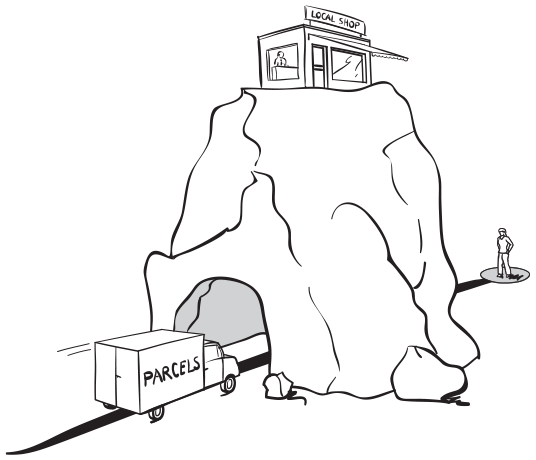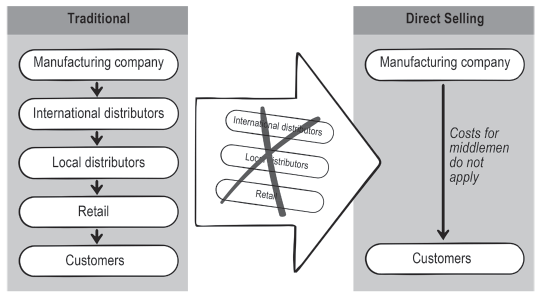Direct Selling
Skipping the middleman

The pattern
In the Direct Selling business model, a company’s products are made available directly by the manufacturer or service provider, rather than via an intermediary channel such as retail outlets (HOW?). This enables the company to eliminate retail profit margins and other costs. Savings can be passed on to the customer (VALUE?). The pattern also facilitates a more personal sales experience with customers and helps the company to better understand their needs, propelling new ideas for improving products and services (WHAT?).

Additionally, Direct Selling allows the company to keep more accurate control of sales information and to safely maintain a uniform and consistent distribution model (HOW?, VALUE?). Customers, for their part, experience the distinct advantage of receiving better service promptly from the company – an important point when the products in question require extensive explanations (WHAT?).
The origins
It goes without saying that Direct Selling is one of the oldest forms of distribution. In the Middle Ages, craftsmen and farmers used Direct Selling almost exclusively to hawk their wares at market and wayside stalls. The modern world has seen a burgeoning of new inventive ways of applying the model, and many exciting business model innovations have come into being.
An example of a company that implemented such a business model innovation is Vorwerk. The German company discovered Direct Selling in the 1930s for its ‘Kobold Model 30’ vacuum cleaner. For this purpose, a network of sales consultants was set up with the aim of visiting clients and selling the vacuum cleaners directly at customers’ doors. As a result, the so-called ‘front-door business’ was invented. Due to this sales strategy, Vorwerk’s sales figures grew rapidly, with more than half a million devices sold after only seven years of market launch. Depicting one core competency of Vorwerk, the firm has maintained the Direct Selling pattern of its products up to this day. Vorwerk currently has around half a million customer advisors selling the company’s products worldwide.
The innovators
Tupperware introduced a new twist in the Direct Selling of kitchen and household products such as plastic containers, serving dishes, bowls and refrigerated storage containers, organising sales events in the homes of its present and potential customers. These consultants and representatives host what are known as ‘Tupperware parties’, to which relatives, friends and neighbours are invited. The representatives are classed in hierarchies to manage a distribution and sales system based on networking activities. Direct Selling enables Tupperware to supply its products without needing a retailer or engendering advertising costs. Brownie Wise (1913–92) is credited with the invention of this concept, when she very successfully started selling Tupperware products to friends and family at home parties in the late 1940s and 1950s in Florida. The founder of Tupperware, Earl Tupper, subsequently asked Brownie Wise to become sales director of the company. She coined the term ‘Tupperware party’ and was instrumental in popularising the concept throughout the United States, earning her the distinction of being the first-ever woman to grace the cover of BusinessWeek.
Hilti, which is headquartered in Liechtenstein and specialises in anchoring systems, is one of the most successful B2B direct vendors in the construction industry. A vast majority of the company’s 29,000 employees are occupied with sales and deal personally with solely professional customers on a daily basis. The company’s high profile in construction has helped it to secure a seemingly unassailable competitive advantage over its competitors. Hilti is best known for its Hilti Centres, and in particular for its expert sales consultants. According to Michael Hilti, the Direct Selling principle was the main success factor in the company’s sustained success. While closeness to the market can be costly, it ensures that customers get what they want.
Direct Selling: the business model innovation

When and how to apply Direct Selling
Direct Selling is widely established: cut out the middlemen and interact directly with your customers. Precise control of the entire sales process serves a dual purpose: first, you can keep tabs on your customers and track their changing needs, and, second, you can optimise the internal coordination of sales with marketing, production and other functions.
Some questions to ask
- What is the value of increased customer intimacy?
- Can we outcompete existing retail companies?
- Can we create and capture value to compensate the high sales costs?
- How must we train our sales force to ensure that every aspect of the sales process is well managed?
